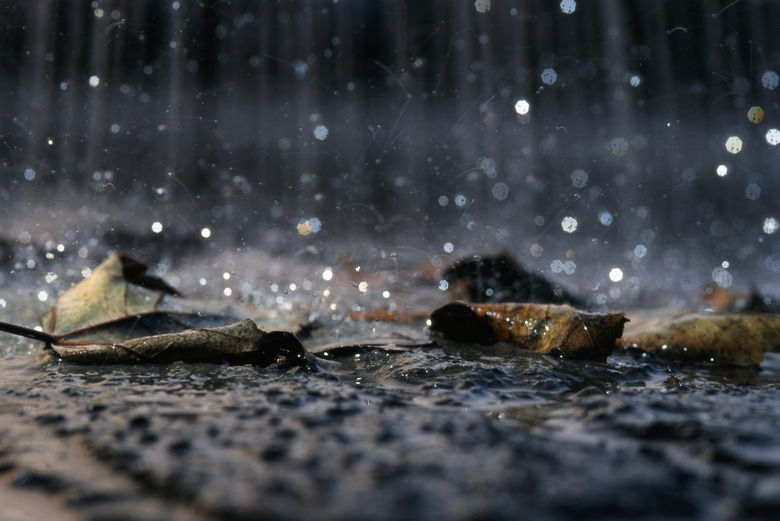Science Projects On The Effects Of Acid Rain On Buildings
As the environment faces pressure from heavy industry and vehicular activity, it can be easy to write off the effects of acid rain as insubstantial because they occur so slowly. Here is an idea for a science project that will show those effects in an accelerated manner. Be forewarned, though — acids can be dangerous to work with, so make sure you understand the warnings listed at the bottom of the page before starting.
Introduction to Acid Rain
Introduction to Acid Rain
Gases in the atmosphere have the ability to react with water to form acidic compounds. For example, rain is normally somewhat acidic because carbon dioxide reacts with water and oxygen to form carbonic acid. With the advent of the Industrial Revolution, factories started to release sulfur dioxide while cars emitted nitrogen oxides. These gases react with water and oxygen to form sulfuric acid and nitric acid, respectively, both far more harmful than carbonic acid (all references).
Things You Will Need
Things You Will Need
The first things you will need are samples of various building materials — the more you can get, the better the experiment — and a camera. Different types of wood, concrete, steel, clay brick, and stones such as marble and granite are all excellent choices. You could even test drywall and other indoor materials. In addition, buy some clear glass to use as a negative control — glass is not affected by sulfuric or nitric acid. If you can, try to get pieces big enough to cover your hand. You will also need several glass containers that are large enough to hold the materials with some room to spare. Chemistry supplies you will need include several Pasteur pipettes, sulfuric acid and nitric acid, and some pH strips or a pH meter.
Experimental Setup and Procedures
Experimental Setup and Procedures
First, place your building material samples in separate glass containers and place the containers somewhere they will not be disturbed. Take a photo of each sample you are testing. Place a folded sheet of computer paper under one side of the containers so that it is very slightly sloped. Next, add sulfuric acid and nitric acid to pure water in a glass container until the pH is around 4 — if the acids are concentrated, you will not need much to reach that level of acidity. Every once in a while — perhaps once or twice a day — spray some artificial acid rain on the building materials using your pipettes. If the container is sloped properly, the liquid will pool on one side. When the pool is large enough, remove and discard it using a pipette. At the end of the time period you set for the experiment, take another photo of the samples and make visual comparisons of the before and after photos. See the final section on warnings for information about working with acids.
Customizing Your Experiment
Customizing Your Experiment
This experiment is highly customizable. You could set up the experiment in such a way that the acid constantly drips on the samples, or you can vary the time between "rains". You can vary the experimental time period as much as you want — even an entire year if you really felt like it! If you wanted to simulate the effects of increasing car or factory emissions, just add more nitric acid or sulfuric acid to your artificial acid rain, respectively. If you wanted to accelerate the effects of your acid rain because you want to keep the experiment short, lower the pH by adding more of each acid.
Warning
Warning
Sulfuric acid and nitric acid are both highly caustic and will burn your skin, eyes, and digestive system should you spill them. Be extremely careful and wear gloves and protective glasses whenever you might come into contact with the acids. Make sure to add acids to water and not the other way around just in case liquid splashes up towards your body. When disposing of your artificial rain, dilute it first with water and then add antacid tablets until the pH is neutral before dumping it down a sink drain.
References
Cite This Article
MLA
Mullis, Robert. "Science Projects On The Effects Of Acid Rain On Buildings" sciencing.com, https://www.sciencing.com/science-projects-effects-acid-rain-buildings-14136/. 24 April 2017.
APA
Mullis, Robert. (2017, April 24). Science Projects On The Effects Of Acid Rain On Buildings. sciencing.com. Retrieved from https://www.sciencing.com/science-projects-effects-acid-rain-buildings-14136/
Chicago
Mullis, Robert. Science Projects On The Effects Of Acid Rain On Buildings last modified August 30, 2022. https://www.sciencing.com/science-projects-effects-acid-rain-buildings-14136/
